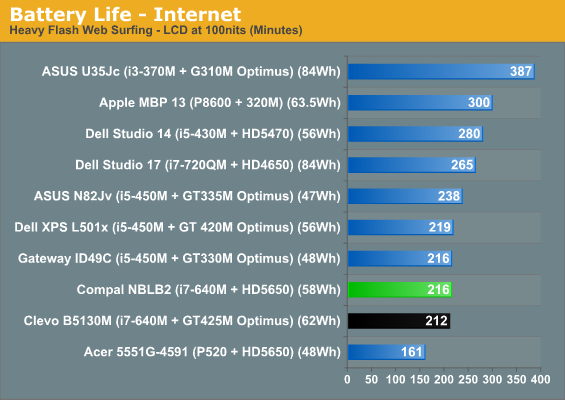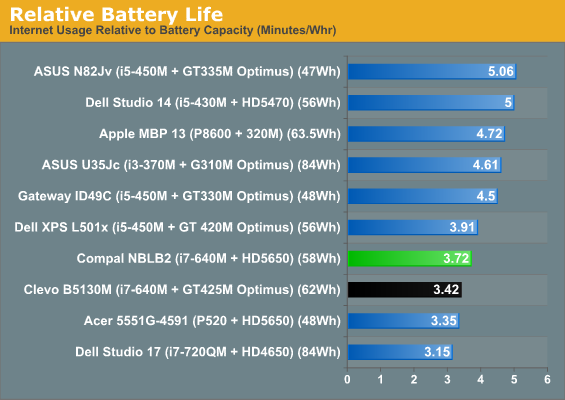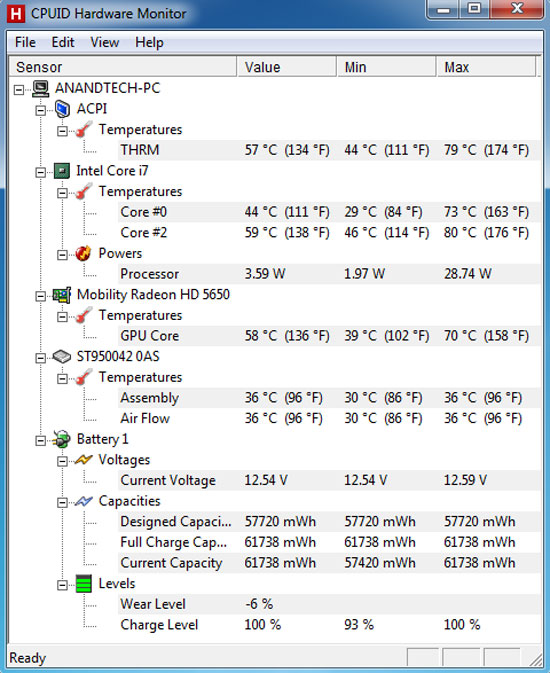CyberpowerPC's Compal NBLB2: Affordable Gaming
by Dustin Sklavos on December 21, 2010 5:50 PM EST- Posted in
- Laptops
- AMD
- Intel
- CyberPowerPC
- Compal
Battery Life
It's at this point we should mention that the battery pack in our review unit has specifications at odds with the Compal NBLB2 sold on CyberpowerPC's site (along with Sager's): they advertise a 4800mAh battery while the one in our unit is marked as 5200mAh. There shouldn't be a massive difference in running time, but it's worth mentioning nonetheless.
This is also where we expect NVIDIA's Optimus technology is going to come in handy and a place where AMD really needs to pick up the slack on pretty much all fronts. AMD mobile processors generally offer poor power consumption compared to their performance, and they don't have anything in their graphics hardware that competes with Optimus.




And there it is. Nearly four hours of runnning time off the chain isn't bad at all, but the Optimus-equipped notebooks (outside of Clevo's B5130M) typically fare a lot better. With the advertised 4800mAh battery, we'd probably expect to lose about fifteen to twenty minutes, leaving running time floating in the neighborhood of three-and-a-half hours. Not shabby, but nowhere near as good as some of the others.
Noise and Heat
If the battery life of the Compal NBLB2 isn't stellar, heat and noise are. The fan spins up under heavy load but it's not too noisy and is easy enough to drown out with music or most game audio. So if the fan doesn't sound like it's working that hard, theoretically heat should be an issue, right?

Or not. The processor cores get a little toasty under sustained load, but nothing too extreme, and the Radeon actually runs at an impressively cool (for a notebook) 70C. It stands to reason the more intrepid user could probably safely overclock the GPU and get some free extra performance without overwhelming the cooling system in the NBLB2. By the same token, though, it looks like the dual-core i7's 35W TDP is already pushing what's comfortable with this chassis, so we're not sure we'd recommend upgrading to a quad-core. Cyberpower offers the 55W i7-920XM as an upgrade, but I have a hard time believing this notebook could cope with that kind of thermal stress.










36 Comments
View All Comments
rangerdavid - Tuesday, December 21, 2010 - link
Love your articles and site in general, but please: When using your DSLR to take a gallery of photos, tighten that aperture down four or five stops from wide-open, as you currently take your photos (probably necessitating a slow shutter speed and a tripod). Yes, some shots lend themselves to nice blurry depth-of-field effect, but not everything.Keep up the great work and Happy Holidays to you all.
JarredWalton - Tuesday, December 21, 2010 - link
I think you've got it backwards... I prefer to shoot at a 14 f-stop and ISO 400, since the low f-stops give you the depth-of-field effect. They let in a lot more light, but I prefer a good flash over the blur. But otherwise I agree; Dustin needs to figure out the pictures better. (Sorry, Dustin, but it's true! At least he's no longer using a point and shoot.)Dustin Sklavos - Tuesday, December 21, 2010 - link
Oh believe me, I know. I'm getting there. Give me a video camera and I'll make it sing, but still photography utterly escapes me for some odd reason.rangerdavid - Tuesday, December 21, 2010 - link
Note: NOT Trying to start a flame war....but I believe I had it right - yet it's confusing and I may not have been clear. A "wide" or "open" aperture is definitely a SMALLER number. This is a bit counter-intuitive. I should have said "tighten that aperture UP a few stops," even though I usually uses the phrase "tighten down" in common speech. I suppose both are common. The point:
Higher f-stop = narrower aperture opening = greater depth-of-field = more of the laptop in focus.
So I agree: Shooting at f/14 is a better choice than the wide-open f/3.5 or whatever he's using now. For more info:
http://www.dpreview.com/learn/?/key=depth_of_field
Deinonych67 - Tuesday, December 21, 2010 - link
You were correct using the term "stopping down" in reference to reducing the aperture size.http://en.wikipedia.org/wiki/Stopping_down
Stuka87 - Tuesday, December 21, 2010 - link
I actually got a kick out of the isometric shot that is on the main page. It basically has a tilt shift effect on it, making it look like something you would buy for your daughters barbie dolls.DanNeely - Tuesday, December 21, 2010 - link
Since it appears that high quality screens are available almost exclusively in glare finishes these days, could you do a review comparing the out of the box quality of the screen with the results after applying a filter to it? Mwave.com and Viewguard.com both sell filters in many sizes, so finding on to fit shouldn't be that difficult.hybrid2d4x4 - Wednesday, December 22, 2010 - link
I second this request. I don't like the dull low-contrast screens any more than any of the others who regularly complain about these things, but I hate glossy screens even more. When I saw the picture of this laptop on the AT front page and saw the reflection of the keyboard, and that glossy plastic on the bezel, my gut reaction was: "Aw, FFS...".Meaker10 - Tuesday, December 21, 2010 - link
Notebook manufacturers typically use different internal coolers for the quad core models, thicker heatpipes and better fans are usually used.Dont assume just because your dual core version was comfortable that it impacts how the quad core model may fare.
CreateAccount - Tuesday, December 21, 2010 - link
looks like a samsung or toshiba.reflective surface, who started this trend? It's never been cool.
what happen to the brushed metal or the touchy plastic surface like the bottom case of the notebook? Bring those things back. That will cut the cost of the notebook. We don't need a notebook to looks pretty, we buy it to WORK! "WORK" that's the main purpose of it. Let those pretty stuff for A*ple, we don't need it.